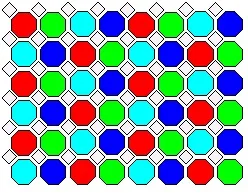In my last article (The Display Resolution War – How much resolution is enough?), I argued that mobile displays will continue to increase in resolution to 1200dpi because the human vision system can see up to 60 cycles/degree, at least for those blessed with the best vision, typically young people, the most important market for mobile devices today.

But it could be expensive, both in terms of lowered manufacturing yields and in power vs. brightness of the display. Fortunately for us, there are a few things we can do about this.
First, we can note that the human vision system has an asymmetry in its resolving power. We have more contrast sensitivity in the horizontal and vertical directions, up to 60 cycles/degree, but in the diagonal directions, we have less resolving power, with a limit of around 40 cycles/degree. We can design displays that take advantage of this asymmetry, putting more resolution in the horizontal and vertical than the diagonals to match the human vision system, with no loss in image quality. This will save on the number of subpixels that are required.
Second, we can focus on reconstructing lines and spaces, not “counting pixels”. The ‘old fashioned’ way of determining the resolution of a display was to draw imaginary boxes with a single red, a single green and a single blue subpixel and call each a full color “pixel”. The resolution was thus the number of these “pixels” in each axis. But the human vision system doesn’t do this, and neither should we. The human vision system separates images into visual channels, luminance and two chrominance channels. When I referred to the limit of the human vision system being 60 cycles/degree, I was referring only to the luminance channel; the chrominance channels have far lower limits at 8 cycles/degree for the red/green channel and 4 cycles/degree for the yellow/blue channel. We can design a display that provides less chromatic resolution, as long as we maintain the luminance resolution. This will save on the number of subpixels that are required.
Here’s the fun part. We do all of this, while also providing a brighter, more colorful display. One of the key ways of gaining brightness, especially when using color filters, is to add a white subpixel into the matrix (e.g. RGBW). In conventional “whole pixel” rendering, this would reduce the resolution. But with subpixel and metamer rendering, this does not occur, if done right. Consider that a white subpixel can substitute for an RGB triad in a metamer exchange (W<>RGB). This will save on the number of subpixels that are required.
Another way to get more colorful displays is to use multiprimary color systems. Again, in conventional “whole pixel” rendering, this would reduce the resolution. But with subpixel and metamer rendering, this does not occur, if done right. Consider that the combination of a new primary, say, cyan, plus red can substitute a white subpixel or an RGB triad in a metamer exchange (RC<>W<>RGB). This will save on the number of subpixels that are required.
Add all of these methods together and we get the PenTile Diamond MultiPrimary layout shown here. With each of the methods of reducing the number of subpixels that are required, this layout is capable of displaying high resolution, high color gamut, at low power, using only one half (0.5) subpixel per input pixel.
Yes, you read that right, less than one subpixel per pixel
on average. Any given input pixel will actually influence the value of many subpixels to reconstruct the lines and spaces in the input image at high resolution. Consider, we can “paint” a line using only W subpixels, or we can “paint” a horizontal line with RGBC subpixels, a vertical line with just RC subpixels, or a vertical line with concentrated energy on GB subpixels, with a bit of R either side. Using subpixel + metamer rendering digital image processing, we can fabricate mobile displays at 1200dpi that use fewer subpixels than a 600dpi using conventional RGB whole pixels.
Of course, we can also use this technology to fabricate 8k resolution televisions using fewer subpixels than 4k RGB panels, and have more color and brightness.
The future of high resolution displays will be bright and colorful. – Candice Brown Elliott

